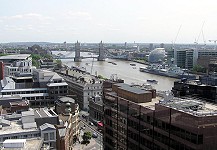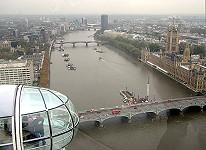|
The River Thames London
|
|||||||||||||
Travel down the Thames on our virtual tour
Long ago, before Britain was separated from continental Europe, the Thames was a tributary of the Rhine. The English Channel was formed about 7,000 years ago at the end of the last Ice Age. The Route of the River Thames The River Thames rises in the Cotswold Hills in Gloucestershire, and flows roughly eastwards passed Oxford (where it is known as the River Isis), until the Chilterns and on through London to the North Sea. Trade and Transport The river has been an important trade and transport route since prehistoric times. London's fame and fortune is due its river. All through the Middle Ages the Thames was one of London's main highways. Barges and river boats brought fish, wood and wool to the City, while hundreds of watermen in small rowing boats ferried people up and down.
The Thames was so busy that traffic on the river could hardly move. Sometimes, dozens of ships queued for days along the banks, waiting to get to a dock to unload. Royal Palaces along the River Thames Flooding
The Thames Flood Barrier was built at Woolwich to protect London from flooding. It is usually left open to let ships go through. In times of tidal surges, the gates are shut to keep the water out of the estuary. River Thames Frost Fairs The worst cold spells in Britain occurred between 1550 and 1750. The climate during this time was known as the Little Ice Age, when winters were so cold that the Thames froze over each year. It was not uncommon for the freeze to last over three months, as in the case of the winters of 1683 - 1684 and 1715 - 1716. The first recorded Frost Fair was held on the frozen river Thames in London in 1608. It had tents, sideshows, food stalls and even included ice bowling! The Thames had frozen over several times before 1608. In the 16th century, Henry VIII is said to have traveled all the way from central London to Greenwich by sleigh along the river during the winter of 1536 and Elizabeth I took walks on the ice during the winter of 1564. The last Frost Fair was held in the winter of 1814. It began on February 1, and lasted just four days. An elephant was led across the river below Blackfriars Bridge. |
|||||||||||||
|
© Copyright Mandy Barrow 2013
Mandy is the creator of the Woodlands Resources section of the Woodlands Junior website.
The two websites projectbritain.com and primaryhomeworkhelp.co.uk are the new homes for the Woodlands Resources.
Mandy left Woodlands in 2003 to work in Kent schools as an ICT Consulatant.
She now teaches computers at The Granville School and St. John's Primary School in Sevenoaks Kent.

 The Thames is only 346 km (215 miles) long. It is England's longest river and the second longest river in the
The Thames is only 346 km (215 miles) long. It is England's longest river and the second longest river in the  By the 1700s, trading ships were arriving carrying all kinds of goods for sale in the City. Tea, silk and a fortune of spices came from the East. Sugar was brought from the Caribbean, timber from Norway and iron ore from Sweden.
By the 1700s, trading ships were arriving carrying all kinds of goods for sale in the City. Tea, silk and a fortune of spices came from the East. Sugar was brought from the Caribbean, timber from Norway and iron ore from Sweden. The River Thames is prone to tidal surges. This happens when a high tide is blown up the Thames estuary by very strong winds. The water level of the Thames rises quickly and spills over the banks.
The River Thames is prone to tidal surges. This happens when a high tide is blown up the Thames estuary by very strong winds. The water level of the Thames rises quickly and spills over the banks. 
 ©
© 
